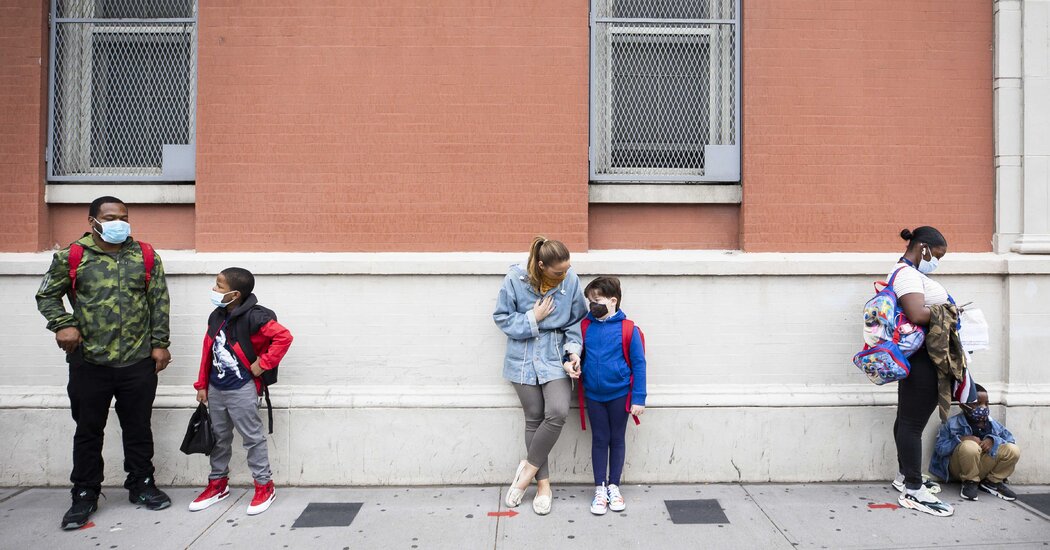A blueprint for the C.D.C. to bring children back to classrooms safely.
As American children conclude what will hopefully be the most discombobulated academic year of their lives, it’s clear that school must be different this fall. Thanks to increasing vaccinations and declining rates of Covid-19 infections, children can safely return to classrooms. To facilitate this, the Centers for Disease Control and Prevention should release a blueprint for reopening schools that balances the countless benefits of in-person schooling with the lower risks of Covid-19 to children and (mostly vaccinated) teachers and staff.
Since the pandemic began, Covid-19 has affected children less than adults, and the risk the disease poses to youths is diminishing as vaccinations increase. Children are about half as likely as adults to spread the coronavirus, and long Covid appears to be uncommon in children. Research in Wisconsin, North Carolina, Utah and New York City has shown that children can be welcomed back to classrooms without substantial viral outbreaks. Leaders in New York City and New Jersey have already said that their schools will reopen fully this fall.
As physicians who study infectious disease and epidemiology, we believe that the best way to prevent Covid-19 from spreading in schools is to vaccinate the adults — teachers, staff and parents — throughout the school. When more people in a community are protected against the coronavirus, unprotected people, such as the children who aren’t yet able to get vaccinated, are less likely to be exposed.
Children ages 12 and older should be encouraged to get immunized, and vaccines are likely to be available for younger children this fall. However, students don’t need to be segregated by vaccination status, nor should they be required to get vaccinated when they return to school. After all, Israel fully reopened schools after Covid-19 surges earlier this year, and cases among children remained low even though no one under the age of 16 had been vaccinated.
The coronavirus will likely still be circulating at low levels this fall, so schools cannot simply operate as they did before the pandemic. But some of the sanitation measures that institutions embraced early in the pandemic have not been found to be effective, so school districts should focus on the tactics that work against transmitting the virus. School staff should frequently clean surfaces that are touched regularly, but the widespread use of antimicrobial cleaning products is unnecessary and could lead to antimicrobial resistance. Many schools have installed plexiglass barriers between desks, but these don’t effectively prevent the spread of the coronavirus and may create obstacles to learning and communication. Schools can also stop taking the temperatures of students when they arrive, as this has not proved to be a reliable screening tool for Covid-19.
Many schools have used regular coronavirus testing to identify infections in their communities.
But we don’t believe testing people without symptoms is appropriate in K-12 schools unless infection rates in a community exceed 200 cases per 100,000 residents in the previous seven days. Screening tests are expensive and labor-intensive to manage, and they can deliver false positive results when administered to asymptomatic people. Schools should continue to require tests for people who have been exposed to Covid-19 or show symptoms. But given that children rarely transmit the coronavirus to one another in school settings when they’re wearing masks, it’s not necessary to quarantine entire classrooms when one child tests positive. However, unvaccinated adults who are exposed to Covid-19 should follow the C.D.C.’s quarantine guidelines.
Face masks have been a vital part of virus mitigation strategies, and they’ve worked. But as the number of Covid-19 cases diminishes, masking guidance requirements can be revisited. The World Health Organization bases its recommendations for indoor masking on local Covid-19 infection rates. We believe that for now, children ages 5 and older should keep wearing face masks indoors. But the United States should consider revising its guidance for children when hospitalization rates fall below five per 100,000 people in a community and two-thirds of adults have received at least one dose of a Covid-19 vaccine.
When children play outside, masks are unnecessary. Research has repeatedly shown that the risk of coronavirus transmission outside is very low. The C.D.C. recently said that unvaccinated children do not need to wear masks outdoors except in crowded settings when rates of viral transmission are high. As long as transmission rates remain low, children should be able to skip the masks while playing outside.
Inside school buildings, desks should remain at least three feet apart until hospitalization rates in the community fall below five per 100,000 people. Schools should make certain that ventilation systems are working properly and that doors and windows are kept open where possible to ensure sufficient air circulation.
Since the pandemic began, the United States has placed a lower priority on teaching children in person than have our British and European counterparts. That has resulted in a substantial learning loss for millions of American children. The science strongly supports getting children back into school full-time this fall.
Tracy Beth Høeg (@TracyBethHoeg) is a physician and an epidemiologist at the University of California, Davis. Monica Gandhi (@MonicaGandhi9) is a professor of medicine at the University of California, San Francisco, and the director of the U.C.S.F. Center for AIDS Research. Daniel Johnson (@DrDanielJohnson) is a professor of pediatrics and the chief of pediatric infectious diseases at the University of Chicago Medicine.
The Times is committed to publishing a diversity of letters to the editor. We’d like to hear what you think about this or any of our articles. Here are some tips. And here’s our email: [email protected].
Follow The New York Times Opinion section on Facebook, Twitter (@NYTopinion) and Instagram.



















